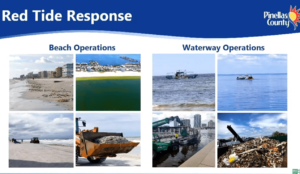Thrive
Governor pledges $14 million to fight red tide

Following what marine scientists called Tampa Bay’s worst red tide outbreak in 50 years, Governor Ron DeSantis announced he is allocating nearly $14 million in this year’s budget to combat the toxic algae blooms.
Speaking Wednesday from Frenchy’s Rockaway Grill in Clearwater, DeSantis said the funding would support research efforts through the Florida Fish and Wildlife Conservation Commission (FWC) and the Sarasota-based Mote Marine Laboratory. The money will also provide grants through the Department of Environmental Protection (DEP) for red tide cleanup efforts.
According to state officials, Florida has invested $40 million to detect and mitigate red tide since 2019.
“Not only do red tide blooms affect our coastal waterways, but impacts of blooms can also negatively impact businesses and decrease tourism,” said DeSantis. “We will continue to proactively work with local partners to ensure Florida is at the forefront of innovative technologies to mitigate against harmful blooms.”
The governor made those statements along the coast of a county that collected over 3.65 million pounds of dead fish during the first two months of last year’s red tide outbreak. Karenia brevis, the organism responsible for red tide, persisted throughout Tampa Bay and off the Pinellas coast from June through October of 2021, turning area waters into a marine graveyard.
According to marine scientists, Karenia brevis feeds off warm water, Saharan dust layers and nutrients such as those found in fertilizer runoff and the 215 million gallons of toxic wastewater officials released from the Piney Point phosphate plant two months before the 2021 outbreak.
DEP Secretary Shawn Hamilton noted that his organization spent $3 million in cleanup efforts throughout several counties and removed 45,000 pounds of marine debris in 2021 – or less than 1% of the dead fish collected by Pinellas County in just the first two months.

Pinellas County officials said they removed over 3.65 million pounds of dead fish from area waters during the first two months of last year’s red tide outbreak. Screengrab.
“What happens is – you have a bloom, you end up seeing these fish, and if you don’t go up and clean it out, it exacerbates all of the problems,” said DeSantis. “So, what we did last summer when you had it in Tampa Bay, is they sent millions of dollars in grants to the counties, and you had FWC, DEP out there trying to do the quick clean up to be able to allow the recovery to happen.”
Out of the $14 million in new funding, the state is allocating $4.8 million for the Center for Red Tide Research at the Fish and Wildlife Institute. The state created the institute in 2019 at the governor’s behest to improve monitoring and research techniques. Since then, red tide sampling has increased by 68%, according to a state release.
During his first legislative session, the governor also established the Florida Red Tide Mitigation and Technology Development Initiative. The program, a partnership between the FWC and Mote, will receive $3 million of the funding as part of its annual appropriation.
Dr. Michael Crosby, president and CEO of Mote, credited DeSantis and the legislature for enabling the state to launch the unique partnership.
“This initiative is bringing together the best and brightest minds in science to utilize innovative approaches and technologies,” said Crosby. “To determine the most effective – but very importantly – ecologically compatible methods for mitigating the adverse effects of red tide.”
DeSantis said the state increased red tide-related funding from $2.5 million to $40 million in his four years as governor, including the announced $14 million addition. He also took a moment to criticize media coverage of red tide outbreaks.
“If there’s one little bloom somewhere like off the coast of Sarasota, the media will act like it’s in every part of Florida,” said DeSantis. “So, it does affect people who work in tourism and hospitality, the restaurants …”

An FWC map showing the widespread extent of Florida’s 2021 red tide outbreak. Photo courtesy of the FWC.
During last year’s outbreak, the FWC found medium to high concentrations of Karenia brevis from the Panhandle to Lee County.







